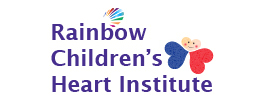If your child has a heart condition and needs a heart transplant, it is normal for you to feel a lot of emotions including worry, sadness, frustration, and anger. All these feelings can get a little overwhelming for a parent who is waiting to get a new heart for their child.
If you are one such parent, you need to know that once your child has the surgery, they will continue to live a normal and healthy life. They might have to have regular checkups and take medications to prevent complications. But otherwise, they will be okay.
What is a heart transplant surgery?
A heart transplant is a surgical procedure in which the doctor will remove your child’s sick heart and replace it with a healthy heart from a donor. This is performed when your child’s heart is not working well and they need a new one to survive. It is often called as end-stage pediatric heart disease or heart failure. At Rainbow Children’s Heart Institute, the treatment for the congenital heart disease will begin with medications and then move on to the surgery.
The new heart will come from an organ donor who has chosen to donate their organs as they wanted to help someone who was sick. Once your kid has a successful heart transplant procedure and they recover, they will have a normal life. They might have to take medications to stop the body from rejecting the new heart.
Before the heart transplant
Once the doctor has decided that your child won’t be able to survive without a heart transplant, you will be referred to a transplant center where you will be meeting the members of your transplant team. The members will include:
- Cardiologists
- Surgeon
- Nurses
- Dieticians
- Transplant coordinator
- Social workers
- Psychologists
The first step is making sure that your child can have surgery. For this, they will perform tests like:
- Blood tests for determining the blood type.
- Echocardiogram for taking an image of the heart through sound waves.
- Electrocardiogram for recording the heart’s electrical activity and finding heart muscle damage and arrhythmias.
- Cardiac Catheterization where a catheter (a thin, plastic tube) is placed inside the blood vessel and threaded through the heart to get a clear view of the heart and its chambers.
In soma cases, the biopsy might be formed where the doctor will remove a small piece of tissue from the heart and examine it.
It is important for you to learn as much as you can about your child’s condition. You need to know what exactly will happen. The team at the Rainbow Children’s Heart Institute will provide you with all the information and support you need. If you are unable to understand something or have a concern, you can always reach out to us.
Once the team has decided that a heart transplant is a good option for your child, the next step is finding the heart. The name of your child will be added to the organ waiting list that includes the names of everyone waiting for a heart. You might have to wait for some time to find a heart that matches your child. During this time, you need to stay in touch with the cardiologists and the healthcare team. As soon as a heart is available, it is important that you move quickly. Have a bag packed at all times so that you can be ready to go to the hospital immediately.
While you are waiting for the transplant, you need to keep your child healthy. This way, when the time comes, they will be ready for the surgery. This includes making them eat healthy foods, taking all the prescribed medications, and keeping all the medical appointments. If there is any change in your kid’s health, tell your doctor right away.
During the heart transplant
As soon as you reach the hospital, our team will start preparing your child for the procedure. We might perform some tests to ensure that the heart is a good match. Next, your child will be taken to the operation theatre where they will be administered with anesthesia so that they sleep through the surgery. The surgeon will remove the sick heart through the incision made in the chest and place the new heart in the chest. The blood vessels of the new heart will be sewed to the blood vessels of the body. The incision will be closed once the doctors have checked the heart function. The whole procedure can take somewhere between 4 to 6 hours. Our team will ensure that you are kept informed at all times.
After the heart transplant
Once the procedure is completed, your child will be staying in the Intensive Care Unit where you will be allowed to visit them for brief periods. A ventilator with a breathing tube will be placed so that the doctors can know if the new heart is working properly or not. Your child might have to stay in the ICU for 7 to 10 days. After that, they will be moved to the general ward.
Thanks to the heart transplant procedure, your child will have a normal and healthy life without congenital heart disease. In fact, they will feel better than they have ever felt before. Make sure that you have regular appointments with our cardiologists to ensure that everything is going well.
